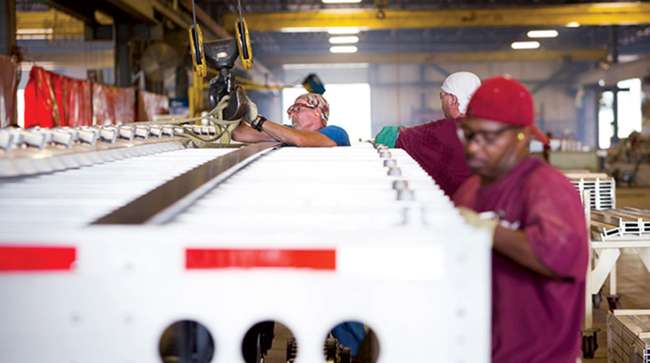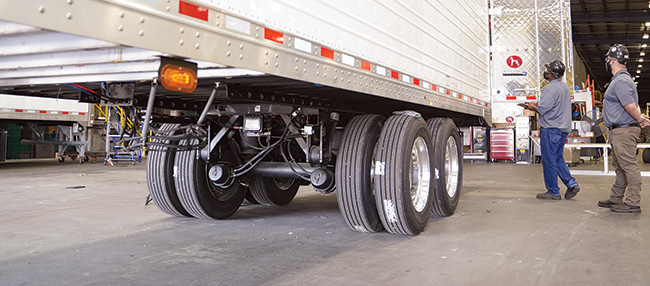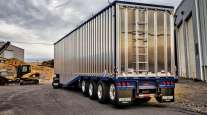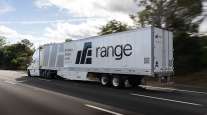High Demand, Rising Component Costs Put Pressure on Trailer Production

[Stay on top of transportation news: Get TTNews in your inbox.]
Fleets looking to order new box trailers this fall — particularly dry van or refrigerated units — may be in for some sticker shock and a long wait.
Executives at four of North America’s largest trailer manufacturers and an industry analyst all agreed that strong equipment demand combined with volatile commodity prices and labor shortages have made it exceedingly difficult for trailer makers to source materials, plan production and set stable prices for 2021 and 2022.
As a result, they predict fleets will continue to experience long lead times between the time of order and expected delivery.
Due to unstable costs for raw materials and components, trailer makers have found that they can’t effectively set prices with enough confidence that they won’t need to ask customers for more money later, said Frank Maly, director of commercial vehicle transportation analysis and research at ACT Research Co.
“The whole thing about the pricing on the component side is that you’ve got trailer manufacturers going back to fleets who have orders on their order boards right now,” he said, adding that the same thing is happening in the truck market as well. “Nobody’s going to be very happy to get a phone call to reopen negotiations.”

Supply chain struggles and rising material costs have been hindering trailer production across the industry. (Great Dane)
However, there generally is a sense of “begrudging acceptance” on the part of fleets because they understand that those market pressures exist, Maly said.
With companies attempting to acquire raw materials across a variety of industries as economies around the world continue to recover from the impact of the COVID-19 pandemic, shortages of materials and components such as lumber, steel, aluminum, tires, suspension parts and wiring harnesses are building within the supply chain and greatly impacting trailer manufacturing and pricing.
Long delays at congested ports on the East and West coasts brought about by labor and container shortages have further exacerbated those component shortages.
Supply Shortages Drive Up Costs
Sean Kenney, chief sales officer for Hyundai Translead, said there isn’t a single specific commodity that’s contributing more than others to factory backlogs or increased production costs.

How do you care for your tires? Host Michael Freeze sets out to answer what factors fleets should consider when investing in TPMS and ATIS. He's joined by Matt Wilson of Hendrickson. Hear a snippet above, and get the full program by going to RoadSigns.TTNews.com.
While the year-over-year cost increase for various raw materials depends greatly on the material in question, “the summation of materials and components are impacting overall costs by greater than 20%,” Kenney said.
Meanwhile, several suppliers continue to face significant labor shortages, he added.
“Component supply has been a continuous struggle across the industry. Even when material capacity is available, other aspects may impact availability such as shipping delays and warehouse space,” Kenney said. “Generally, demand has been so high that requests for 2021 have essentially blended into 2022. The industry simply needs equipment as fast as can be managed. Our 2022 numbers are as strong as the numbers we see right now for 2021.”
Maly said the backlog issue faced by Hyundai Translead is an endemic challenge across the trailer industry. In 2018, the historic high-water mark for trailer production, manufacturers were building an average of more than 1,300 units per day — peaking at more than 1,500 units daily in June of that year, he added. This year, trailer manufacturers are producing more than 1,000 units per day.
“That being said, we’ve got backlogs that are at least, compared to last year, three times what they were at this point a year ago,” Maly said.
Backlogs are the major reason why lead times for many trailers from order to delivery are as long as several months.
Chris Hammond, executive vice president of sales at Great Dane, said the trailer industry, like most others around the world, is dealing with a stressed supply chain with suppliers unable to obtain raw materials for their own needs.
“What are the greatest pain points?” Hammond asked. “Rising costs of raw materials such as steel, lumber and aluminum? It’s tough to point to a single pain point as our manufacturing teams are dealing with instances every day in every plant and as they forecast to later in the year, they still see gaps in supply.”
It may be a while before the situation improves, Hammond noted, as material costs continue to increase.

Yeagy
Wabash National Corp. CEO Brent Yeagy voiced similar concerns. Speaking with analysts on the company’s April 28 earnings call, Yeagy said robust industrial and consumer demand across the broader manufacturing landscape has created imbalances throughout an array of manufacturing supply chains.
“I would say the rise of material cost has been greater than anything we could have reasonably expected, given that we are in uncharted territory with all-time highs in a number of commodities,” Yeagy said during the earning call. “When you’ve got steel prices that have gone up, when you’re bumping against the $1,400 per ton spot market, [over $900 more per ton than the year prior], those are just real and transparent conversations that you’re going to have with the customer in order to maintain a viable business.”
Labor Shortage Limits Production
Material inflation is also a concern for Stoughton Trailers, but a worker shortage is an even greater problem, said David Giesen, the company’s vice president of sales.
“Labor is one of our top concerns. It does not appear that this will get better anytime soon,” Giesen said. “With more labor we could build more trailers — until we reach the caps on components. But at this point, labor is the constricting factor for us.”
Wabash’s Yeagy echoed Giesen’s concerns about recruiting enough workers.

Giesen
“Hiring remains a challenge,” Yeagy said. “And after a relatively successful fourth quarter, our intake of new team members was less than desired during the first quarter and reflective of the general reality of the U.S. labor market.”
Still, Yeagy remains confident that a set of actions to attract and retain employees the company initiated earlier this year will continue to have a positive impact going forward. And the company anticipates that it will see productivity gains in the third and fourth quarters from the employees who were hired earlier this year, he said.
Meanwhile, ACT’s Maly believes that as COVID-19 infection rates remain low and vaccination rates increase, the safety measures implemented by trailer makers during the pandemic may no longer be necessary. Manufacturers took steps last year to create spacing for adequate social distancing on the assembly line, which negatively impacted productivity, he said.
“There’s no question that [trailer manufacturers] would prefer to be staffing up at a much faster rate,” Maly added. “Maybe, as we progress through the year and get through the summer, hopefully, after school systems are back on somewhat of a level type of scheduling operation pattern, more people will be able to return to work.”
Want more news? Listen to today's daily briefing below or go here for more info:




